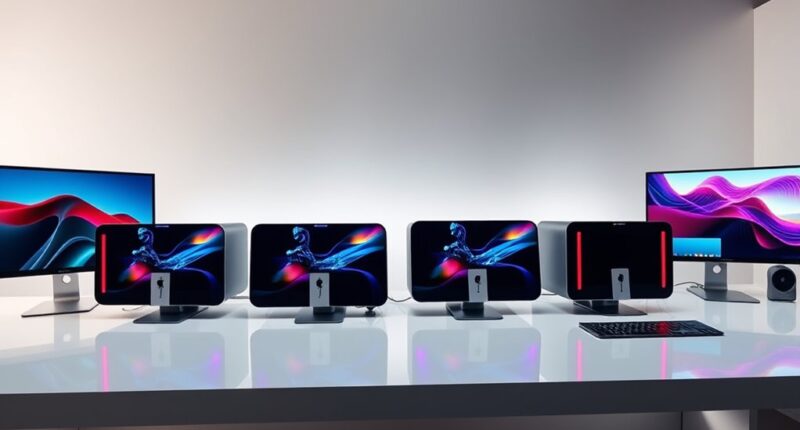In 2025, the best Mac Studio models for 3D rendering include those with the latest M4 and M4 Pro chips, offering powerful CPUs, GPUs, and up to 64GB RAM. The Mac Studio’s compact size combines high performance with great connectivity, perfect for demanding creative projects. If you want smooth workflows, fast rendering, and room to grow, these models are worth considering. Keep exploring to discover which options suit your needs best.
Key Takeaways
- The latest Mac Studio models equipped with M4 and M4 Pro chips offer exceptional processing and GPU power for demanding 3D rendering tasks.
- Configurations with up to 64GB RAM and extensive SSD storage ensure smooth handling of complex scenes and large project files.
- Advanced connectivity options, including multiple Thunderbolt ports and high-resolution display support, enhance workflow efficiency.
- Optimized for Apple Silicon, these models deliver faster rendering speeds and better hardware-accelerated ray tracing capabilities.
- Choosing the right model depends on balancing performance needs, future-proofing storage, and connectivity for long-term creative freedom.
Apple Mac mini Desktop Computer with M4 Chip, 16GB RAM, 512GB SSD

If you’re looking for a compact yet powerful option for 3D rendering in 2025, the Apple Mac mini with the M4 chip is an excellent choice. Its small size—just 5×5 inches and 2 inches tall—makes it perfect for tight spaces, yet it delivers impressive performance. The M4 chip features a 10-core CPU, 10-core GPU, and a 16-core Neural Engine, ensuring fast processing and rendering. With 16GB of unified memory and a 512GB SSD, it handles demanding tasks smoothly. Plus, it supports multiple displays and seamlessly integrates with the Apple ecosystem, making it a versatile tool for creative professionals.
Best For: creative professionals and tech enthusiasts seeking a compact, high-performance computer for 3D rendering and demanding tasks in 2025.
Pros:
- Compact size fits easily into small workspaces without sacrificing power
- Advanced M4 chip with 10-core CPU and GPU ensures fast rendering and processing
- Seamless integration with the Apple ecosystem and support for multiple high-resolution displays
Cons:
- Limited upgrade options for RAM and storage after purchase
- Higher price point compared to some traditional small-form-factor PCs
- May require adapters or additional accessories for certain peripherals and display setups
Apple Mac mini Desktop Computer with M4 Chip (2024)

The Apple Mac mini Desktop Computer with M4 Chip (2024) stands out as an ideal choice for creative professionals seeking a compact yet powerful workstation. Its five-by-five-inch design fits easily next to monitors, making it perfect for tight spaces. Powered by the M4 chip, it offers a 10-core CPU, 10-core GPU, and 16-core Neural Engine, delivering impressive performance for 3D rendering and multitasking. With up to 32GB of unified memory and fast SSD options, it handles demanding workflows smoothly. Support for multiple high-resolution displays and seamless Apple ecosystem integration make it a versatile, eco-friendly option for creative work.
Best For: creative professionals and small workspace users seeking a compact, high-performance desktop with seamless Apple ecosystem integration.
Pros:
- Compact size fits easily next to monitors, ideal for tight spaces
- Powerful M4 chip with 10-core CPU and GPU for demanding workflows
- Supports multiple high-resolution displays and extensive connectivity options
Cons:
- Limited storage options starting at 256GB, which may require external solutions for heavy data storage
- Up to 32GB of unified memory might be insufficient for extremely intensive tasks
- Only available starting October 29, 2024, which may delay immediate purchase or deployment
Apple 2024 Mac mini Desktop Computer with M4 Chip

The Apple 2024 Mac mini with the M4 chip stands out as a compact powerhouse ideal for professionals who need reliable performance in a small form factor. Its 10-core CPU, 10-core GPU, and 16-core Neural Engine deliver smooth multitasking and fast rendering—perfect for demanding creative work. With 24GB of unified memory (upgradable to 32GB) and fast SSD storage, it handles large files effortlessly. Its versatile connectivity includes multiple Thunderbolt 4 ports, HDMI, Ethernet, and front USB-C ports. Weighing just 1.5 pounds, it fits easily next to any monitor, making it a flexible, eco-friendly choice for 3D artists and creative professionals.
Best For: creative professionals and tech enthusiasts seeking a compact, high-performance desktop for demanding workloads and seamless ecosystem integration.
Pros:
- Powerful 10-core CPU and GPU deliver smooth multitasking and fast rendering
- Compact, lightweight design easily fits next to monitors or in small workspaces
- Multiple connectivity options including Thunderbolt 4, HDMI, Ethernet, and front USB-C ports
Cons:
- Limited upgradeability beyond initial configuration
- Higher price point compared to traditional mini desktops with similar specs
- No dedicated graphics card, which may impact performance for some intensive tasks
Apple 2024 Mac mini Desktop Computer with M4 Pro chip

Powerful yet compact, the Apple 2024 Mac mini with M4 Pro chip is built for demanding creative workflows, making it an ideal choice for professionals who need serious performance in a small form factor. Measuring just 5×5 inches and weighing 1.6 pounds, it easily fits next to monitors or in tight spaces. Its M4 Pro chip features a 12-core CPU, 16-core GPU, and 16-core Neural Engine, supporting intensive tasks like 3D rendering and code compilation. With up to 64GB of unified memory and customizable storage up to 8TB, it offers flexibility and speed. Plus, its extensive port selection guarantees seamless connectivity for multiple displays and high-speed data transfer.
Best For: creative professionals and power users needing a compact yet high-performance desktop capable of handling demanding workflows and multiple displays.
Pros:
- Compact design fits easily on desks or next to monitors, saving space.
- Powerful M4 Pro chip with a 12-core CPU and 16-core GPU ensures exceptional performance for intensive tasks.
- Extensive connectivity options support multiple displays and high-speed data transfer.
Cons:
- Limited upgradeability due to integrated hardware design.
- Higher cost for maximum configurations with 64GB RAM and 8TB storage.
- No dedicated GPU options, which may be a concern for certain high-end gaming or specialized applications.
Factors to Consider When Choosing a Mac Studio for 3D Rendering

When selecting a Mac Studio for 3D rendering, I focus on several key factors that impact performance. These include processing power, graphics capabilities, memory, storage options, and connectivity features. Understanding how each of these elements aligns with my specific needs helps me make the best choice.
Processing Power Needs
Choosing the right Mac Studio for 3D rendering hinges on understanding how processing power impacts performance. Higher core counts in the CPU speed up rendering times for complex scenes, making production more efficient. A robust GPU with multiple cores accelerates real-time viewport rendering and high-resolution outputs, indispensable for detailed projects. Sufficient RAM is essential to handle large models smoothly and to enable multitasking during intensive workflows. Hardware-accelerated ray tracing enhances realism and cuts down processing times for photorealistic images. Ultimately, the CPU and GPU combination determines how effectively you can manage resource-heavy projects, ensuring your workflow remains seamless and responsive. Prioritizing these processing power factors helps you choose a Mac Studio that meets your rendering demands now and in the future.
Graphics Capability
The GPU plays a central role in determining a Mac Studio’s graphics capabilities for 3D rendering. A high-performance GPU with ample VRAM—16GB or more—is vital for handling complex scenes efficiently and reducing render times. Support for hardware-accelerated ray tracing boosts visual realism, making powerful GPUs even more important. Compatibility with graphics APIs like Metal ensures optimized rendering performance and stability in demanding applications. The number of GPU cores and overall processing power directly influence how well the Mac can manage large textures, detailed models, and high-resolution outputs. When choosing a Mac Studio, prioritizing a GPU that meets these criteria will substantially enhance your 3D rendering experience, giving you the power and flexibility needed for professional-grade projects.
Memory Capacity
Having enough memory capacity is vital for smooth 3D rendering, especially with complex scenes and large files. With at least 32GB of RAM, a Mac Studio can handle demanding tasks more efficiently, reducing lag and bottlenecks. Upgrading to 64GB or more considerably cuts down rendering times and enhances multitasking, allowing me to work on multiple projects or high-resolution textures simultaneously without slowdown. Sufficient memory ensures I can work with detailed models, high-res textures, and real-time previews without hiccups. It’s an important factor because inadequate memory can bottleneck performance, forcing me to simplify scenes or wait longer for renders. In 3D work, having ample memory directly correlates with smoother workflows and faster results, making it a key consideration when selecting a Mac Studio.
Storage Options
Selecting the right storage options is crucial for smooth 3D rendering on a Mac Studio, especially when working with large files and complex scenes. I recommend opting for larger SSDs, like 1TB or 2TB, to handle hefty assets efficiently without bottlenecks. It’s important to balance storage capacity with your project needs, ensuring you have enough space for current work and future growth. External solutions such as Thunderbolt 4 or USB-C drives can further expand storage and boost data transfer speeds, making workflows more seamless. Faster SSDs with higher read/write speeds can markedly cut down rendering and exporting times, saving valuable time. When choosing your Mac Studio, consider future-proofing by selecting ample storage now, so your setup remains capable as project sizes increase over time.
Connectivity Features
When choosing a Mac Studio for 3D rendering, paying close attention to connectivity features is essential to guarantee smooth workflows. I look for models with multiple Thunderbolt 4 or Thunderbolt 5 ports to connect high-speed external devices and multiple displays simultaneously. An HDMI port supporting high resolutions, like 6K or 8K, is indispensable for seamless connection to advanced monitors. USB-C ports supporting USB 3.2 or USB 4 are critical for fast data transfer with external storage and peripherals. I also verify that the device supports native DisplayPort 1.4 or higher over USB-C for versatile display options. Finally, Ethernet connectivity, ideally 10Gb Ethernet, is key for fast network transfers, especially during collaborative projects or large file uploads. These features ensure a robust, efficient workflow for demanding 3D rendering tasks.
Compatibility With Software
Ensuring your chosen Mac Studio is compatible with your preferred 3D rendering software is essential for a smooth workflow. I recommend checking that your software, like Blender, Maya, or Cinema 4D, supports the latest versions and is optimized for Apple Silicon, so you can fully utilize the hardware’s power. Compatibility with GPU acceleration is also critical, as it greatly enhances rendering speed and quality. Make sure the Mac Studio’s operating system works seamlessly with your plugins and add-ons, avoiding any potential conflicts. Additionally, verify that the software supports multi-threading and hardware encoding, allowing you to harness the multi-core CPU and Neural Engine efficiently. These considerations ensure your setup is optimized for high-performance, reliable 3D rendering workflows.
Frequently Asked Questions
How Does GPU Performance Impact 3D Rendering Speed on Mac Studio Models?
GPU performance directly affects how quickly I can render complex 3D scenes on a Mac Studio. A powerful GPU accelerates calculations, reducing render times substantially. When I choose models with high-performance GPUs, I notice smoother workflows, faster previews, and more efficient handling of demanding projects. In short, a strong GPU is essential for boosting my productivity and achieving high-quality results in 3D rendering tasks.
What Are the Advantages of the M4 Pro Chip Over Standard M4 for Rendering Tasks?
Did you know the M4 Pro chip offers up to 20% faster rendering speeds than the standard M4? I’ve found that the M4 Pro’s enhanced GPU and increased core count substantially boost performance on complex 3D projects. It handles multitasking seamlessly, reducing render times and improving creative flow. If you’re serious about rendering efficiency, the M4 Pro’s advanced features make a noticeable difference over the standard M4.
Is RAM Upgradeability Available in Mac Studio Models for Future-Proofing?
Yes, Mac Studio models currently offer RAM upgradeability, so you can future-proof your setup. I recommend choosing a configuration with ample RAM now, as some models allow upgrades later. This way, you won’t be limited as your projects grow more complex. Upgrading RAM can enhance performance for 3D rendering and multitasking, ensuring your Mac Studio stays powerful and relevant for years to come.
How Do Storage Options Influence Large Project Workflows in 3D Rendering?
Storage options are like a reliable highway for my large 3D projects—more space means smoother traffic and faster access. When I choose ample SSD storage, I avoid bottlenecks and reduce render times, making my workflow seamless. For intense projects, I prefer higher capacity drives or external options, ensuring I never run out of room or slow down my creative process. More storage truly keeps my creative journey flowing effortlessly.
Which Mac Studio Configurations Offer the Best Value for Professional 3D Artists?
If you’re looking for the best value, I recommend the Mac Studio with the M2 Ultra chip, 64GB of RAM, and a 2TB SSD. It balances power and affordability, making it perfect for demanding 3D projects. You get superb rendering speed, smooth multitasking, and ample storage without overspending. For professional artists, this setup delivers exceptional performance and future-proofing, ensuring your workflows stay efficient and creative.
Conclusion
Just like Da Vinci’s mastery fueled his masterpieces, choosing the right Mac Studio can elevate your 3D rendering to new heights. Whether you opt for the compact power of the M4 or the might of the M4 Pro, these models release your creative potential. Remember, it’s not just about hardware—it’s about turning your artistic visions into reality. So, pick your champion, and let your creativity soar beyond the horizon.









